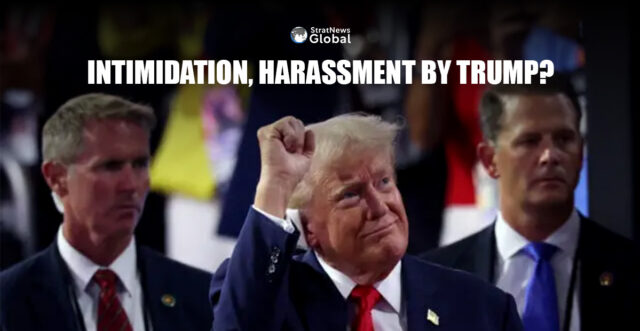When U.S. congressman Tom Rice voted to impeach Donald Trump for inciting the mob that stormed the U.S. Capitol in January 2021, it was the beginning of the end of his political career.
Angry calls and emails – including three death threats – flooded the South Carolina Republican’s office. The next year, as Rice ran for a sixth term, a sheriff’s deputy often guarded him at public events. Trump backed Rice’s foe in the party’s primary election. At a rally, the ex-president warned voters that the congressman “partnered with the Democrats to stab the Republican Party and, frankly, to stab our country in the
back.”
Rice got crushed in the primary. Today, the one-time conservative darling, a small-government fiscal hawk, is shunned by former allies and some old friends, he told Reuters. He feels betrayed by fellow Republicans who, “rather than upholding their
oath and defending the Constitution, decided their position and their power was worth more.”
Menace, Harassment
In cementing his third-straight Republican presidential nomination, Donald Trump and his staunchest followers have used menace and harassment to fundamentally reshape the party of Reagan, purging officials and activists seen as insufficiently loyal to Trump and his Make America Great Again agenda.
Trump has imposed this fealty at every level of the party, from minor state and local officials to members of Congress, cabinet secretaries and rivals for the presidency, calling for revenge on those who resist his demands, vote against his interests or cross his allies.
Since launching his Truth Social media platform in early 2022, Donald Trump has posted more than 600 attacks on fellow Republicans, singling out more than 100 party officials,
activists and right-leaning media figures for condemnation, according to a Reuters review of his nearly 20,000 posts during that time.
One recent target: Brian Kemp, Republican governor of the battleground state of Georgia, which Trump narrowly lost in 2020. Trump berated Kemp at an Aug. 3 rally as “Little Brian” for refusing to help overturn the last presidential election. Trump framed his Kemp attack as part of a broad cleansing of the party.
“He’s a bad guy. He’s a disloyal guy,” Trump said of Kemp. Earlier that day, he wrote on Truth Social: “We have to purge the Party of people that go against our Candidates and make it harder for a popular Republican President to beat the Radical Left.” Kemp did not respond to a request to comment.
Ultimate Weapon
Donald Trump’s ultimate weapon is his coveted endorsement, often wielded to drive the disloyal from office. Since the start of 2022, he has endorsed Republican challengers against at least 13 members of his own party in Congress who he’s accused of betrayal, a Reuters review of his endorsements shows. All but three of the 13 lost their seats or quit the race.
And of the 10 Republican members of the House of Representatives who voted to impeach him, just two remain in office. Four lost to Trump-backed primary challengers, including
Liz Cheney, a former member of the Republican House leadership, and four opted not to run again. At least seven were threatened or harassed by Trump backers, according to police reports, court records and their own public statements.
Donald Trump also subjects lower-tier party officials to opprobrium, often triggering copycat harassment and political defeat. More than a quarter of his Republican targets on Truth Social were state legislators, state judges, local election officials and other relatively low-profile political figures, Reuters found.
Asked about the former president’s attacks on his fellow Republicans, Trump campaign press secretary Karoline Leavitt said, “President Trump continues to build a historic and unified political movement to make America strong, wealthy and safe again.”
Glenn Rogers, a conservative Texas legislator and rancher, faced intimidation after joining a vote last year to impeach the state’s attorney general, Ken Paxton, a Trump ally, over
allegations that he abused his office to benefit a donor. Paxton ultimately was acquitted, but the vote sparked rage from the Republican right – and ultimately from Trump himself.
One Facebook post warned Rogers he should prepare to “face your maker.” Vandals spray-painted RINO – short for Republican in name only – on his campaign signs. Then, days before the party’s nomination vote, Donald Trump ripped Rogers on social media, calling him a RINO and endorsing his Republican opponent, who unseated him.
The fallout “was like a tsunami,” Rogers said in an interview. “There’s people that actually worship Trump like a deity.” He still plans to vote for Trump, dismissing Democrats
as too far left.
Reuters documented at least 39 cases of elected national and state Republican officials who have been threatened or harassed since 2021 for taking actions or expressing views seen as contradicting Trump and the MAGA agenda. Targets included Republicans who question Trump’s false claim that the 2020 election was stolen.
“Menace is a big part of the power,” said Sarah Longwell, a former Republican strategist who publishes the Bulwark, an anti-Trump publication, and runs Republican Voters Against
Trump, a political action group. Republicans who oppose Trump must consider the possibility they’ll face threats or intimidation from his supporters and be driven from politics, she said. “It’s hard to disaggregate the fear of political violence and the fear of career suicide.”
The result: By the time Donald Trump accepted the Republican presidential nomination on July 18, the party was fully behind him. Most of his prominent Republican critics had fallen in line – including his most potent challenger, former South Carolina Governor Nikki Haley, and onetime Attorney General William Barr. Both called Trump unfit for office but later recanted and said they would vote for him.
With Reuters inputs
Thirty eight years in journalism, widely travelled, history buff with a preference for Old Monk Rum. Current interest/focus spans China, Technology and Trade. Recent reads: Steven Colls Directorate S and Alexander Frater's Chasing the Monsoon. Netflix/Prime video junkie. Loves animal videos on Facebook. Reluctant tweeter.





